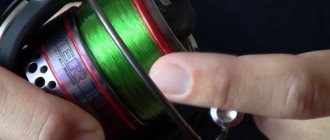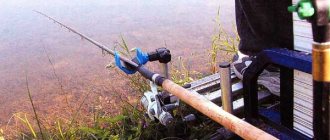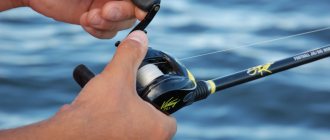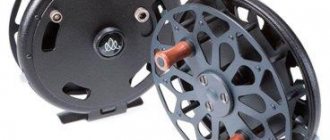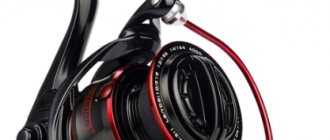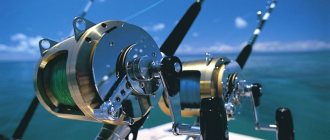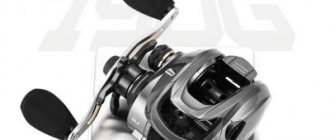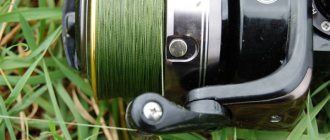When choosing a reel for carp fishing, you need to focus on models for long casting. When fishing for carp, it most often happens that a promising fishing spot is located at a distance of over 80 meters from the shore.
To cast a heavy sinker or feeder over such a distance, you will need a strong, long rod in combination with a large reel, which must have a special spool shape, high-quality winding and sufficient line capacity.
Let's start with the fact that the longest cast depends heavily on the ease of the line coming off the spool.
The casting distance of the reel is affected by the following parameters:
- Spool size.
- Spool shape (cone).
- Winding quality.
- Spool profile (depth).
- Smoothness of the spool edge.
The wider the spool, the more line flies off when casting. Therefore, all carp reels for long-distance casting are equipped with large and wide conical spools, the so-called “Long Cast”.
The spool profile, that is, its depth, also influences the range. Shallower spools are called low profile spools, and the reason for this shape is that when casting, the line rubs against the side of the reel at a lower angle, which creates less friction (more line slip).
The spool material (coating) also affects friction; the smoother it is, the better. There are spools made of pure aluminum, and there are models with a special anodized coating, titanium and other materials.
Carp reel pull
The torque of a carp reel depends on its gear ratio, which is indicated on the spool and shows the number of rotor revolutions per revolution of the handle, for example, a value of 5:1. The higher this value, the faster the reel winds the line, but the weaker its pull. Reels with a 4:1 gear ratio are much more powerful than those with a 5.5:1 ratio.
A gear ratio that is too high means that when working with heavy weights and large fish, the reel is subject to more wear and tear, which in theory reduces its service life. And a smaller gear has a certain power reserve, making it more durable.
To extend the life of the carp reel, try not to put a large load on it, but work by deflating the rod.
Inertial multiplier reels (“multipliers, multipliers”)
Multipliers are equipped with mechanisms for braking the spool, changing the gear ratio, and sometimes with a line counter and line layer. Particularly powerful multipliers are used when trolling. In a baitcasting reel, the spool rotates both during casting and when reeling in the line. This mechanism of action leads to the fact that the casting energy is transferred to the spool and fishing line, which, if cast incorrectly, leads to spontaneous removal of the fishing line and the formation of a beard. To achieve good results using these reels for long casting of small, lightweight lures, the angler must have good casting skills and a keen feel for the cast. The classic baitcasting reel is equipped with a gear system, which, in each specific case, allows you to select the appropriate gear ratio. The gear ratio is the numerical relationship between the number of turns of the handle and the number of turns of the spool. It is usually indicated on the reel body. Let's say the numbers on the reel are 4.4-1. This means that with one revolution of the reel handle, the spool will make 4.4 revolutions. Thus, the gear ratio of this reel is 4.4. A modern multiplier reel is almost as good as a spinning reel in terms of ease and casting range, and in terms of power and reliability it has no equal. An important element of a multiplier reel is a friction brake, which allows you to avoid tangling of the fishing line when casting. Choose reel models with adjustable friction brake. It must be adjusted for each specific casting weight. Fine adjustment will allow the line to flow smoothly, without twisting around its own axis, when casting. The high strength and power of the multiplier reel allows it to be used for catching large fish. Most often, baitcasting reels are used for spinning and sea fishing. A multiplier reel can be used on almost all gear where reliability, power and quality are needed.
The importance of baitrunner in carp fishing
Any carp reel must be equipped with a baitrunner, which is an additional spool friction that is turned off by pressing a button (bracket). The baitrunner performs two important tasks: it releases the fishing line and signals with a ratchet.
Without a baitrunner, a carp can take away your expensive fishing rod, along with the reel, fishing line and equipment in a few seconds. Moreover, there are cases when, when biting, the rod-pod with all the rods turns over, stands are torn off, etc. In general, you shouldn’t underestimate the power of large carp; they will drag your gear into the depths, and you won’t have time to get there, so a baitrunner is very important.
Beginner mistakes when casting a feeder
Long casting of the feeder is a complex technique that requires skill. In any business, beginners make mistakes. The most popular of them:
- Incorrect selection of materials.
- Wrong choice of fishing spot. It is worth looking for a shore without trees and thickets in order to avoid entanglement.
- Rush. Check your tackle thoroughly before each throw. Even the slightest tangling of the fishing line can cause the top to break off.
- Lowering the rod after the cast. As a rule, due to the flexibility of the action, the rod compensates for the load on the fishing line and prevents it from breaking. The correct way to cast a feeder is to hold the rod vertically after casting. This is an important rule to remember.
Having thoroughly prepared, trained in casting, and read the recommendations on the topic of fishing with feeder casting, do not forget that fishing should bring pleasure to the fisherman. This is perhaps the most important point in all types of fishing. Do what you love and everything will work out.
About bait boats
To accurately and quickly feed the fishing point, you can use a radio-controlled carp boat. The advantage of such a device is that it can be loaded with several kilograms of bait, and also have an echo sounder (sensor) on board, which is very convenient for scanning the bottom and fish.
Although such a toy is quite expensive, and not every angler can afford it, it brings a lot of benefits and pleasure. If you want to get acquainted with the models of carp boats, we recommend visiting the Carpboat online store. They have an assortment of eight models of carp boats, echo sounders and other useful things for fishing.
If you are interested in the topic of choosing spinning reels, we recommend that you read our new review.
Author of the article: Vitaly Leonidovich Ivanov, 2021.
Tackle for long casting. Coil selection
One of the most important components of long-casting gear is a spinning reel. We often hear from fishermen that while fishing for a large fish, some kind of incident happened with the reel. Either the friction brake is jammed, or fishing is completely impossible due to the misalignment of the main axis.
Therefore, the choice of reel must be approached with increased demands, since the reel is purchased not for one season, but for at least 3-5 years. And with proper use, a good reel can serve you for a long time and faithfully.
What should you pay attention to when purchasing? First, you must match the reel to your rod. Try to match the class of the reel with the class of the rod. I do not recommend installing reels from elite companies of the highest quality on rods costing 100-200 UAH and vice versa. By the way, very often you see a mediocre Chinese reel for 15 UAH on an expensive rod.
For match rods, reel manufacturing companies produce special models labeled Match. These reels have an elongated and shallow spool, which allows you to wind thin line without additional winding or lining. If for some reason you were unable to purchase a match reel, then winding under the spool is easiest to do from fishing line with a diameter of 0.25-0.3 mm. I do not recommend winding with insulating tape, because in the summer the reel is exposed to the sun, and when heated, the adhesive coating flows off the tape and gets onto the fishing line, which also, with its pressure, squeezes all the glue onto the surface, which makes the fishing line unsuitable for fishing.
When choosing a reel, you should pay attention to the gear ratio. I fish with a reel with a gear ratio of 1:7, but I find that 1:6 is also acceptable. A lower gear ratio is no longer desirable, since after an idle hookup you will be exhausting the tackle for a long time in order to re-bait it and re-cast it. Athletes use reels with a gear ratio of 1:7 and 1:7.5 and a spool of increased diameter.
Once, during a training session before a competition in Rostov, I boasted to a Russian athlete about my reel with a 1:6 gear; in response, he offered to bet that his reel was faster. Together we throw the gear at the same distance of about 40 m and, on command, begin to reel it out. I was three seconds late, which was enough for him to attach the bloodworm and re-throw. It had a reel with a gear ratio of 1:7 and a larger spool. After that I bought myself the same reel.
A lot has been written about the number of bearings in spinning reels. On my own behalf, I will add, agreeing with many athletes, that their number should not exceed 5 pieces. Once, a friend of mine bought a reel with the inscription “12 bearings” and brought it to me to evaluate. There was nothing special about it, and when we tried to imagine where we could place 12 bearings, my friend was the first to laugh, because there was simply nowhere to place them in such quantity. The optimal option for placing bearings: two on the main axis, two on the handle axis and one in the line roller.
A lot of different reels have passed through my hands, starting with Orion and ending with Shimano Stradic.
“Orion” (this is a reel made by Soviet designers) had one bearing and served me for 2 years, after which I gave it to my friend while fishing. By this time I had already purchased a Ryobi RSX-2 reel. This reel seemed like a work of art at the time I purchased it. True, there were no bearings in it, and their function was performed by a perfectly made bushing on the main axis. Like the Orion, I had no complaints about the RSX other than its weight. But then, due to my inexperience, I purchased a Chinese-made reel, which is not that bad, but it’s absolutely impossible to put a “Quality Mark” on them. Of the three reels I bought over the course of 4 years, two failed. One started slipping due to a lot of play, and I had to insert shims to make the gears touch more tightly, but ultimately it had to be replaced with a new one. The second reel, apparently, was also caught with a defect, because when casting, the line handler latched and the tackle made such a jerk back in flight that then it took a long time to untangle the rig.
After all these troubles, I decided to spend more money so that long-casting fishing would bring me pleasure and not test my nervous system. So I got a Shimano Stradic 3000M reel. I bought it in 1996 and to date I have not found a better model than this one. The reel has 3 bearings, a double friction brake, which allows you to very finely adjust the line release when the fish jerks, an instant stop system, as well as an anti-vibration system and a double handle. This model is an example of quality for me. Its components and parts work flawlessly. How many fishing trips were carried out in the rain, and sand got in, but it was enough to rinse it right there in the reservoir and you could do without disassembling it.
After five years of use, more out of curiosity than necessity, I disassembled the reel and was simply surprised - the lubricant looked like new, and I didn’t even bother changing it.
In 2001, Shimano released the same series of reels, only with improved characteristics. The number of bearings has increased to the optimal 5 pieces, the gear ratio has become 1:7, and the design will satisfy the most demanding esthete. When I saw this model, called the Stradic X 3000 GTMH, I couldn't resist and bought two coils at once. Now at competitions I have the opportunity to prepare three spare rods for long casting at once.
Daiwa reels also have a reputation for high quality products, but, unfortunately, I myself have not yet fished with reels from this company, but I’m thinking of correcting this omission.
S.Burdak “FISHERMAN Ukraine”

